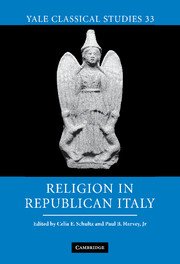Book contents
- Frontmatter
- Contents
- List of illustrations
- List of contributors
- Acknowledgments
- List of abbreviations
- Introduction
- Chapter 1 Reconsidering “religious Romanization”
- Chapter 2 In search of the Etruscan priestess: a re-examination of the hatrencu
- Chapter 3 Etruscan religion at the watershed: before and after the fourth century bce
- Chapter 4 Religious locales in the territory of Minturnae: aspects of Romanization
- Chapter 5 Religion and memory at Pisaurum
- Chapter 6 Inventing the sortilegus: lot divination and cultural identity in Italy, Rome, and the provinces
- Chapter 7 Hot, cold, or smelly: the power of sacred water in Roman religion, 400–100 bce
- Chapter 8 Religion and politics: did the Romans scruple about the placement of their temples?
- Chapter 9 Juno Sospita and Roman insecurity in the Social War
- Chapter 10 Beyond Rome and Latium: Roman religion in the age of Augustus
- Bibliography
- Index
Chapter 1 - Reconsidering “religious Romanization”
Published online by Cambridge University Press: 08 January 2010
- Frontmatter
- Contents
- List of illustrations
- List of contributors
- Acknowledgments
- List of abbreviations
- Introduction
- Chapter 1 Reconsidering “religious Romanization”
- Chapter 2 In search of the Etruscan priestess: a re-examination of the hatrencu
- Chapter 3 Etruscan religion at the watershed: before and after the fourth century bce
- Chapter 4 Religious locales in the territory of Minturnae: aspects of Romanization
- Chapter 5 Religion and memory at Pisaurum
- Chapter 6 Inventing the sortilegus: lot divination and cultural identity in Italy, Rome, and the provinces
- Chapter 7 Hot, cold, or smelly: the power of sacred water in Roman religion, 400–100 bce
- Chapter 8 Religion and politics: did the Romans scruple about the placement of their temples?
- Chapter 9 Juno Sospita and Roman insecurity in the Social War
- Chapter 10 Beyond Rome and Latium: Roman religion in the age of Augustus
- Bibliography
- Index
Summary
During the latter part of the fourth century bce in Italy, mass-produced terracotta votive offerings in the form of human body parts began to be dedicated in vast quantities at sanctuaries. They included representations of internal and external organs (wombs, hearts, and “polyvisceral plaques” showing grouped internal organs such as heart, lungs, liver, and intestines), heads and half-heads, limbs, digits, tongues, eyes, ears, external genitalia, hands and feet (the two commonest types of anatomicals), and “masks” (human faces on rectangular plaques). Associated terracotta offerings included models of swaddled babies, animal figurines, and representations of worshippers, predominantly small “Tanagra-style” statuettes of draped females (so called from the Boeotian town where examples were first found). Such votives, offered up as part of a ritual act, and then displayed in the sanctuary and/or ritually buried, predominate in votive deposits of the Hellenistic period (down to c. 100 bce), and are assumed to have connotations of healing and fertility, human and animal. As most are mould-made, and judged to be of relatively small artistic merit, they are commonly thought to have been the inexpensive donations of the poorer members of society, offered as requests or in thanks for a cure, or in connection with childbirth.
Several approaches have been taken to this material.
- Type
- Chapter
- Information
- Religion in Republican Italy , pp. 10 - 33Publisher: Cambridge University PressPrint publication year: 2006
- 12
- Cited by



